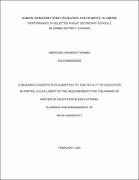| dc.contributor.author | Obedling, Johnson Thombu | |
| dc.date.accessioned | 2024-03-29T09:27:29Z | |
| dc.date.available | 2024-03-29T09:27:29Z | |
| dc.date.issued | 2024-02-22 | |
| dc.identifier.citation | Obedling, J.T. (2024). School infrastructure utilization and students’ academic performance in selected public secondary schools in Zombo district, Uganda (unpublished graduate dissertation). Muni University, Arua, Uganda. | en_US |
| dc.identifier.uri | http://dir.muni.ac.ug/xmlui/handle/20.500.12260/630 | |
| dc.description | A desertation submitted to the Faculty of Education in partial fulfillment of the requirements for the award of a Master's Degree in Educational planning and management of Muni University. | en_US |
| dc.description.abstract | The study aimed to examine the effect of school infrastructure utilization on students’ academic performance in selected public secondary schools in the Zombo district of Uganda. The objectives of the study were to examine the effect of direct school infrastructure utilization, indirect school infrastructure utilization, and co-curricular infrastructure utilization on students’ academic performance in selected public secondary schools in the Zombo district of Uganda. A cross-sectional study design was used. Both quantitative and qualitative approaches were adopted with a sample of 224 respondents. A simple random sampling technique was used to select amongst the students, while purposive sampling was used to select the headteachers and directors of studies. Quantitative data analysis consisted of descriptive statistics (frequencies and percentages) and inferential statistics (Pearson correlation) while qualitative analysis used a thematic approach. Findings revealed a moderate positive correlation (r = .503) between direct infrastructure utilization and students’ academic performance; a moderate positive correlation (r = .475) between indirect infrastructure utilization and students’ academic performance; a weak positive correlation (r = .382) between co-curricular infrastructure and students’ academic performance. Results of regression analysis of the independent infrastructure utilization variables (direct, indirect & co-curricular) revealed that a unit increase in direct infrastructure utilization leads to an improvement in students’ academic performance by 30.3%, indirect infrastructure utilization by 35.6%, and co-curricular infrastructure utilization by 43.6% and all were statistically significant at 1%. However, results of joint regression indicate that direct infrastructure utilization (19.5%) improves academic performance better than co-curricular (16.8%) and direct infrastructure utilization (13.9%). Thus, it was concluded that school infrastructure utilization significantly affected academic performance in selected public secondary schools in the Zombo district of Uganda. It is recommended that secondary schools in the Zombo district of Uganda should focus on school infrastructure utilization to improve students’ academic performance. | en_US |
| dc.language.iso | en | en_US |
| dc.publisher | Muni University | en_US |
| dc.subject | School infrastructure utilization | en_US |
| dc.subject | Academic performance | en_US |
| dc.subject | Public secondary schools | en_US |
| dc.subject | Zombo DIstrict | en_US |
| dc.subject | Uganda | en_US |
| dc.title | School infrastructure utilization and students’ academic performance in selected public secondary schools in Zombo district, Uganda | en_US |
| dc.type | Thesis | en_US |

